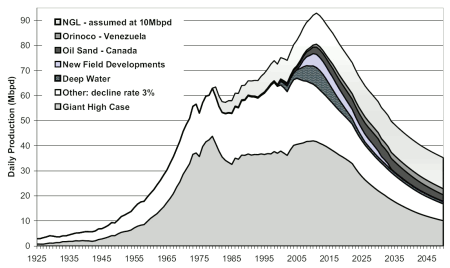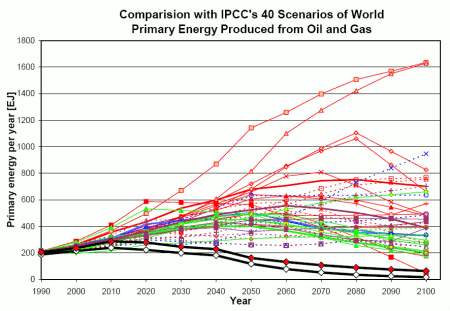The precondition for any of these temperature increases is that we consume large volumes of oil, natural gas and coal. The fact that the IPCC calls upon our politicians to make decisions that will discourage use of fossil fuels creates an impression that enormous fossil fuel resources exist: but following the research that we do at the Uppsala Hydrocarbon depletion study Group, UHDSG, there is every reason to question this.
At Uppsala University, we study global energy resources and we have now completed a detailed analysis of future oil production. By breaking down production into seven well-defined parts we can now give a timeframe for the moment when we will reach the maximum production rate for oil, or “Peak Oil” - the historical production peak.
It will occur between 2008 and 2018. If the world’s giant oilfields, that produce 60 per cent of the world oil, behave like Cantarell we have a “worst case scenario” with a production peak in 2008. But if, instead, they follow the best prognosis for Cantarell, and we simultaneously reduce our consumption, then we get a “best case scenario” with maximal production in 2018. The “Giant High Case” is shown in Figure 2:
Advertisement

Figure 2: A scenario for world oil production built on optimistic assumptions for oil contributions from the seven types of oil source (NGL - natural gas liquids, heavy oil from the Orinoco region of Venezuela, Canadian oil sands, new conventional oil fields, production in deep water, the Giant High Case and an optimistic low decline of just 3 per cent for the rest of today’s conventional oil production) [Thesis of Fredrik Robelius].
We can now calculate how much energy/carbon dioxide we can expect to produce this century if the oil is used and compare it with the energy that the IPCC-families require. To our amazement we see that all the families, A1, A2, B1 and B2, require more oil than is realistic.
If we extend our analysis and study future natural gas production and what the IPCC families require we get an even clearer picture. Natural gas production is declining in North America, as is production in the gigantic Russian gas fields in northwest Siberia that today accounts for 90 per cent of Russian production. Planned projects to make diesel fuel from natural gas in Qatar are being cancelled. Planned reception terminals for liquefied natural gas in the USA and Europe are being down-sized because the global production of liquefied natural gas is now not expected to be what we were counting on a few years ago.

Figure 3: IPCC’s 40 scenarios for world primary energy production from oil and gas 1990 - 2100 compared to the production according to the oil depletion model. The group All Oil and Gas includes heavy oil, extra heavy oil, deepwater oil, polar oil, gas plant NGL, condensate, and non-regular gas e.g. coal bed methane [
Anders Sivertsson].

Advertisement
Natural gas is considered by many to be a “bridging fuel” to a future renewables-based society. Today the bridge seems to be shorter than previously believed, but in terms of carbon emissions once again we stand to benefit.
The third component to be considered for carbon dioxide emissions is coal. The commonly held belief is that virtually unlimited quantities of coal exist, but when we make detailed analyses of production profiles in those six nations that have 85 per cent of the world’s coal reserves, USA, China, Russia, Australia, India and South Africa, we discover clear signs that coal production in particular regions has reached maximum capacity. Furthermore, we see a decline in production of the best coal, i.e. that which has the highest energy content.
In the USA, the world’s second largest coal user, the volume of coal mined is increasing but its total energy content is decreasing. The USA has reached a coal maximum, “Peak Coal”, in terms of energy content.
Discuss in our Forums
See what other readers are saying about this article!
Click here to read & post comments.
44 posts so far.